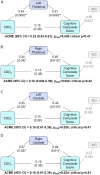Individualized brain development and cognitive outcome in infants with congenital heart disease
- PMID: 33860226
- PMCID: PMC8032964
- DOI: 10.1093/braincomms/fcab046
Individualized brain development and cognitive outcome in infants with congenital heart disease
Abstract
Infants with congenital heart disease are at risk of neurodevelopmental impairments, the origins of which are currently unclear. This study aimed to characterize the relationship between neonatal brain development, cerebral oxygen delivery and neurodevelopmental outcome in infants with congenital heart disease. A cohort of infants with serious or critical congenital heart disease (N = 66; N = 62 born ≥37 weeks) underwent brain MRI before surgery on a 3T scanner situated on the neonatal unit. T2-weighted images were segmented into brain regions using a neonatal-specific algorithm. We generated normative curves of typical volumetric brain development using a data-driven technique applied to 219 healthy infants from the Developing Human Connectome Project (dHCP). Atypicality indices, representing the degree of positive or negative deviation of a regional volume from the normative mean for a given gestational age, sex and postnatal age, were calculated for each infant with congenital heart disease. Phase contrast angiography was acquired in 53 infants with congenital heart disease and cerebral oxygen delivery was calculated. Cognitive and motor abilities were assessed at 22 months (N = 46) using the Bayley scales of Infant and Toddler Development-Third Edition. We assessed the relationship between atypicality indices, cerebral oxygen delivery and cognitive and motor outcome. Additionally, we examined whether cerebral oxygen delivery was associated with neurodevelopmental outcome through the mediating effect of brain volume. Negative atypicality indices in deep grey matter were associated with both reduced neonatal cerebral oxygen delivery and poorer cognitive abilities at 22 months across the whole sample. In infants with congenital heart disease born ≥37 weeks, negative cortical grey matter and total tissue volume atypicality indices, in addition to deep grey matter structures, were associated with poorer cognition. There was a significant indirect relationship between cerebral oxygen delivery and cognition through the mediating effect of negative deep grey matter atypicality indices across the whole sample. In infants born ≥37 weeks, cortical grey matter and total tissue volume atypicality indices were also mediators of this relationship. In summary, lower cognitive abilities in toddlers with congenital heart disease were associated with smaller grey matter volumes before cardiac surgery. The aetiology of poor cognition may encompass poor cerebral oxygen delivery leading to impaired grey matter growth. Interventions to improve cerebral oxygen delivery may promote early brain growth and improve cognitive outcomes in infants with congenital heart disease.
Keywords: MRI; brain; cognition; congenital heart disease; dHCP.
© The Author(s) (2021). Published by Oxford University Press on behalf of the Guarantors of Brain.
Figures




References
-
- EUROCAT. Eurocat Prevalence Tables. 2015. http://www.eurocat-network.eu/accessprevalencedata/prevalencetables. Accessed 06 November 2019.
-
- Latal B. Neurodevelopmental outcomes of the child with congenital heart disease. Clin Perinatol. 2016;43(1):173–185. - PubMed
-
- Marino BS, Lipkin PH, Newburger JW, et al.Neurodevelopmental outcomes in children with congenital heart disease: Evaluation and management: A scientific statement from the American Heart Association. Circulation. 2012;126(9):1143–1172. - PubMed
Grants and funding
LinkOut - more resources
Full Text Sources
Other Literature Sources
